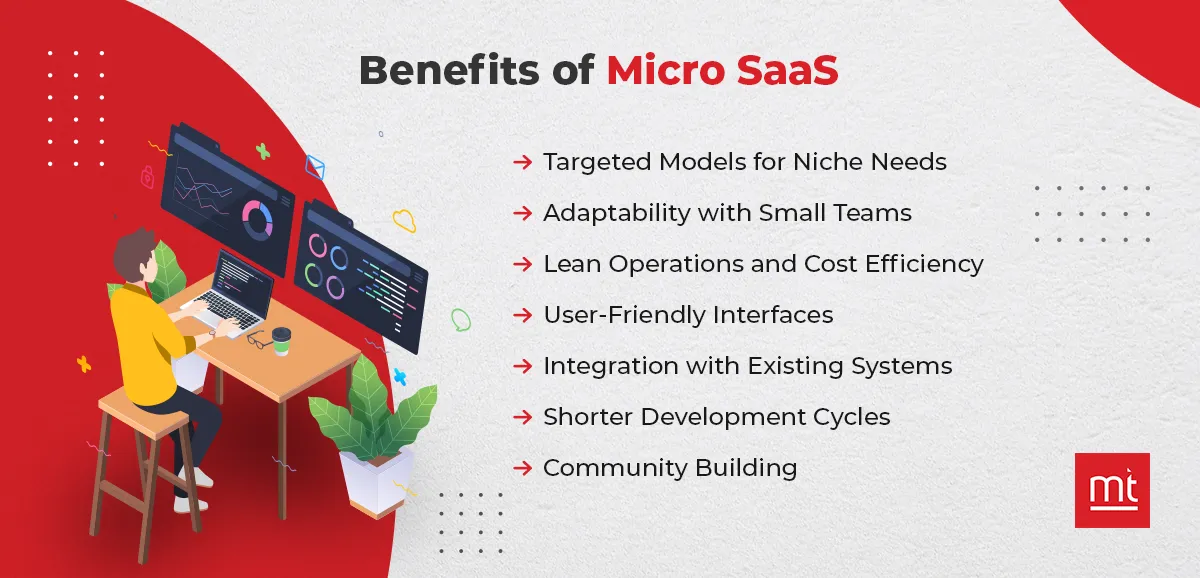Are you a problem solver and have innovative ideas to address issues faced by a large number of people? With the help of Micro SaaS models, you can turn this ability of yours into a full-fledged business with minimal resources!
A micro SaaS business is a small-scale software-as-a-service model that has a very focused niche target audience. These are usually run by small organizations or solo founders who aim at a high revenue while also cutting overhead costs.
Micro SaaS business models are flourishing in the contemporary entrepreneurial landscape, especially with the rise of technological advancements like no-code platforms, which enable developers to build software applications without a lot of prior experience and knowledge of coding and programming. Some of these platforms, like Bubble, Zapier, and Webflow, allow these users to implement their ideas without having to spend a lot on an extensive team or resources. This makes the process of software development much more hassle-free and efficient.

Let us discuss the success stories of a few micro SaaS businesses that went from being mere startups to inspirational role models to others:
- CoverDoc:
- CoverDoc is the success story of affordable pricing strategies combined with just the right marketing tactics. Ambar Shrivastava, the founder of this business model, launched it with a subscription price of just $9.99.
- They participated in mail campaigns and No-Code Day to promote their brand, so they were at the right place at the right time. This kind of effective distribution leads to enhanced customer acquisition in a lesser amount of time.
- CoverDoc reached an astounding conversion rate of 64% of free users to paying customers, depicting the trust their product could gather from the masses.
- Just within the first six months of their launch, their MRR (Monthly Recurring Revenue) was $1250, and hence, they could generate a sustainable income.
- By providing real-value solutions, CoverDoc could make a prominent place for itself in the marketplace.
- CoAlias:
- When Ab Advany struggled with assigning specific domains to each of his clients, he came up with a remarkable idea that led to the development of this multi-functional domain management service.
- It was initially designed to cater to Ab's personal use only, but its vast usability and problem-solving abilities encouraged him to expand it into a full-fledged service.
- It's an ideal example of the scalability of micro SaaS business models with its huge network of as many as 60,000 domains.
- Through its various features that allow users to manage, configure, and use multiple domains, CoAlias caters to the needs of several other businesses and has gained numerous trusted customers.
- Seefunnel:
- By providing innovative tools for automating lead generation and optimizing the sales funnel, Seefunnel enables businesses to streamline their sales processes.
- Using this Micro SaaS model, businesses can form more data-driven decisions as it utilizes artificial intelligence to scrutinize user data.
- It eliminates the need for manual labor for engaging with potential clients by the automation of cold outreach through emails. This is one of its most distinguishing features.
- It allows businesses to make their sales page visually appealing and convincing by providing them with a huge number of remarkable ready-to-use templates.
- Small businesses and organizations can make the best use of Seefunnel to skyrocket their model through its efficient and cost-effective tools.
- BetterLegal:
- With BetterLegal, your business registration can become much more streamlined and seamless, as it can reduce the time taken by registration processes from 4 hours to just 10 minutes.
- By using no-code platforms like Bubble, Chad Sekonchik, the founder of BetterLegal, could cut costs and dependency on developers. This transition led to an increase of 56% in their Monthly Recurring Revenue (MRR).
- With their new and innovative solutions, they had an edge over other businesses that relied on traditional methods of development.
- The success story of BetterLegal portrays how one can compete in today's crowded industries by using no-code platforms to their full potential.
- TaskMagic:
- When Jeremy Redman found himself frustrated with the limited automating features provided by Zapier, he decided to develop a platform that enables users to create custom automations.
- Started off as a simple tool with a tally form, Taskmagic went on to reach $30,000 as its monthly recurring revenue with just 200 customers.
- By giving a lot of significance to customer feedback, Jeremy stresses the need for a direct connection with your clients and providing them with high-value solutions for their genuine concerns.
- By this example, we can see how crucial it is to recognize challenges faced by users that have not been solved yet and come up with creative tools to address them.
- Qoins:
- Paying off credit cards and student loans becomes much easier with Qoins, as it applies the spare change to their debt after automatically rounding off their daily expenses.
- This company could efficiently expand its services by raising a total funding of about $2.25. This enabled them to scale their operations significantly.
- For customers who are in dire need of managing their finances, Qoins positions itself as a very valuable tool as it allows them to pay off their debts without constantly thinking about it.
To conclude, we can say that one can build innovative micro SaaS business models to provide real-value solutions to customers with the optimum use of democratizing platforms like no-code tools, artificial intelligence, etc. With the right problem-solving mindset and effective business strategies, you can turn your idea into a full-fledged business model.